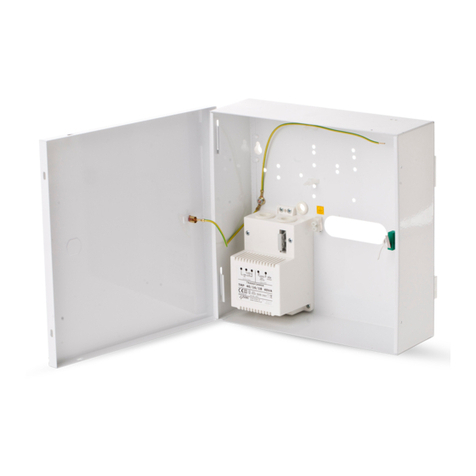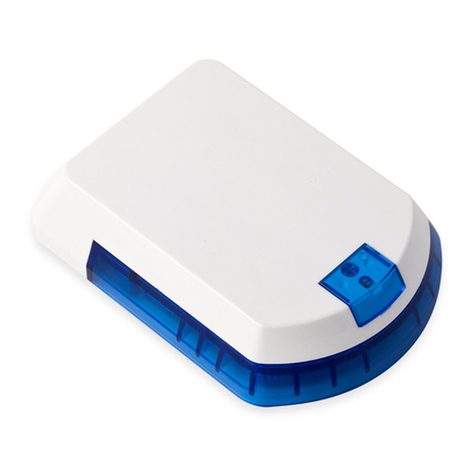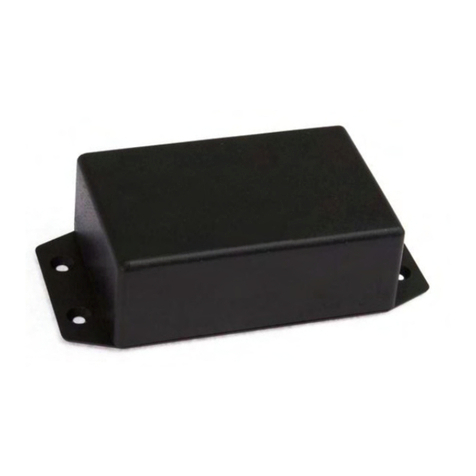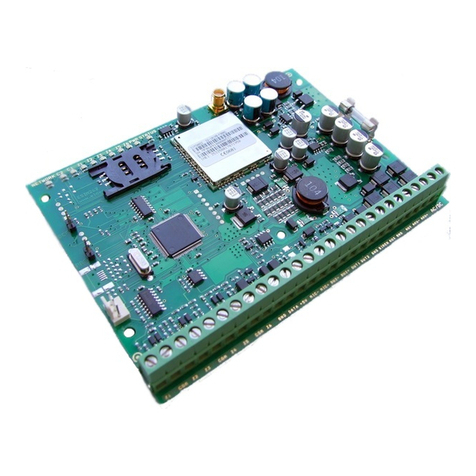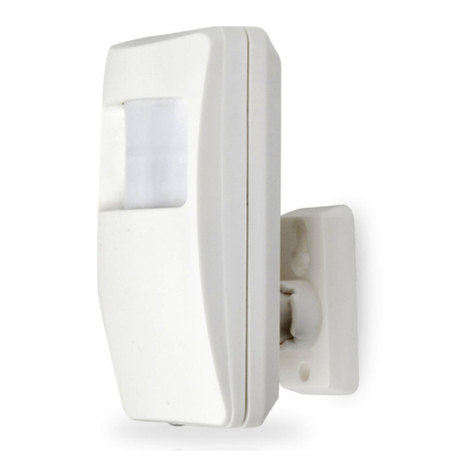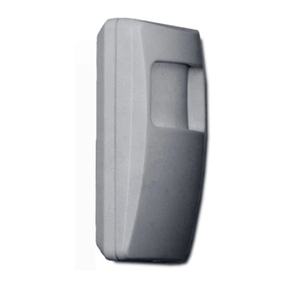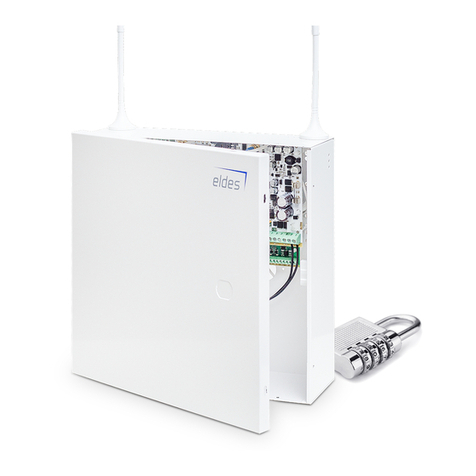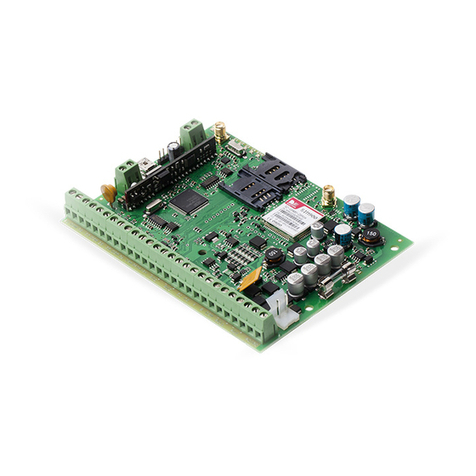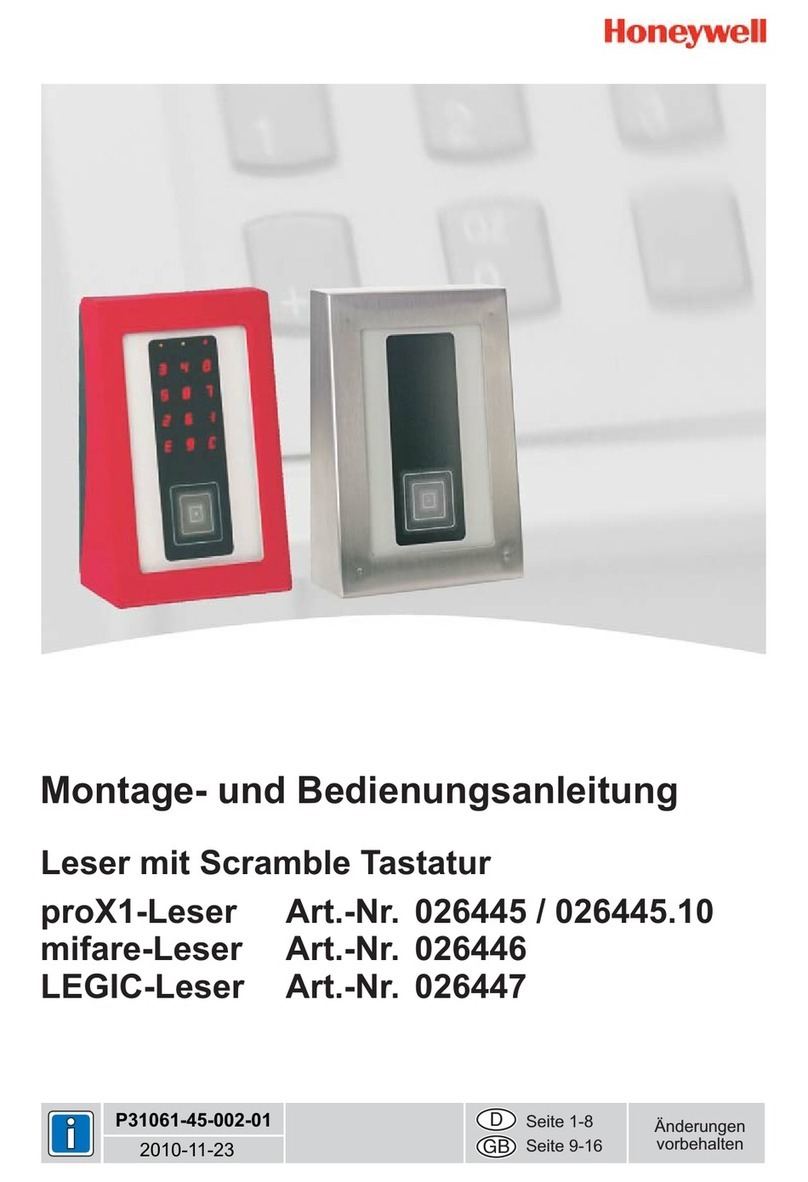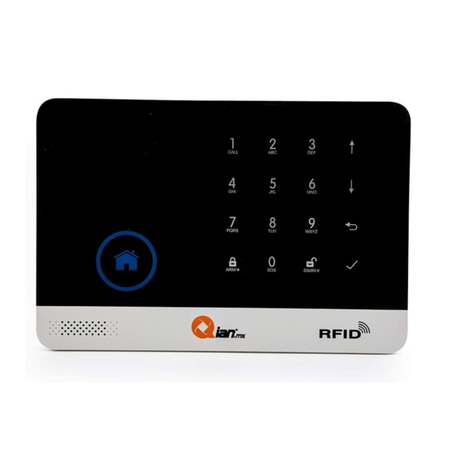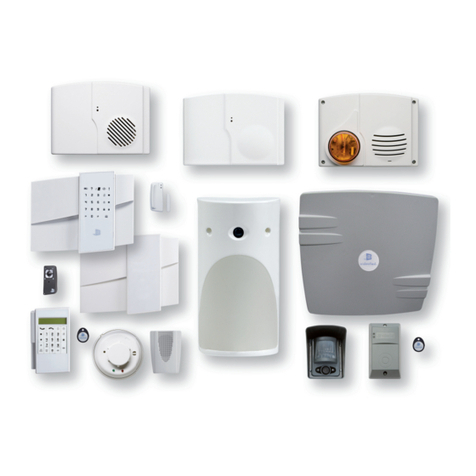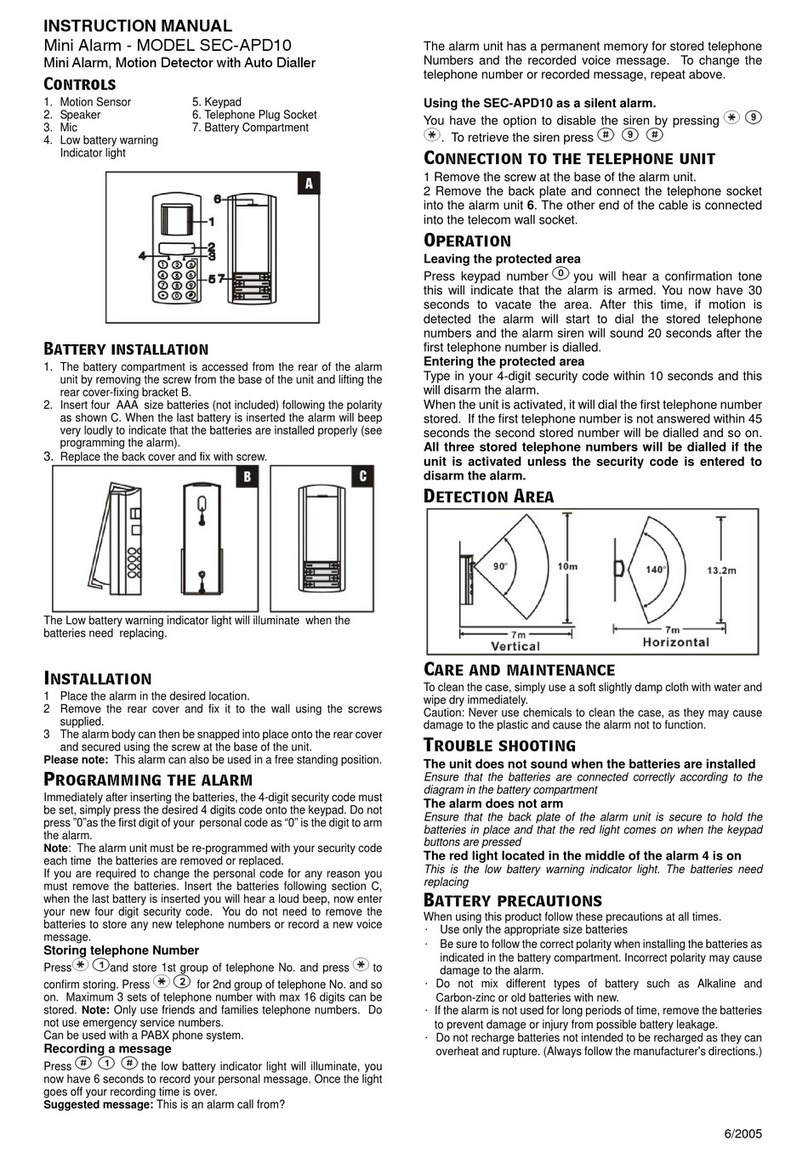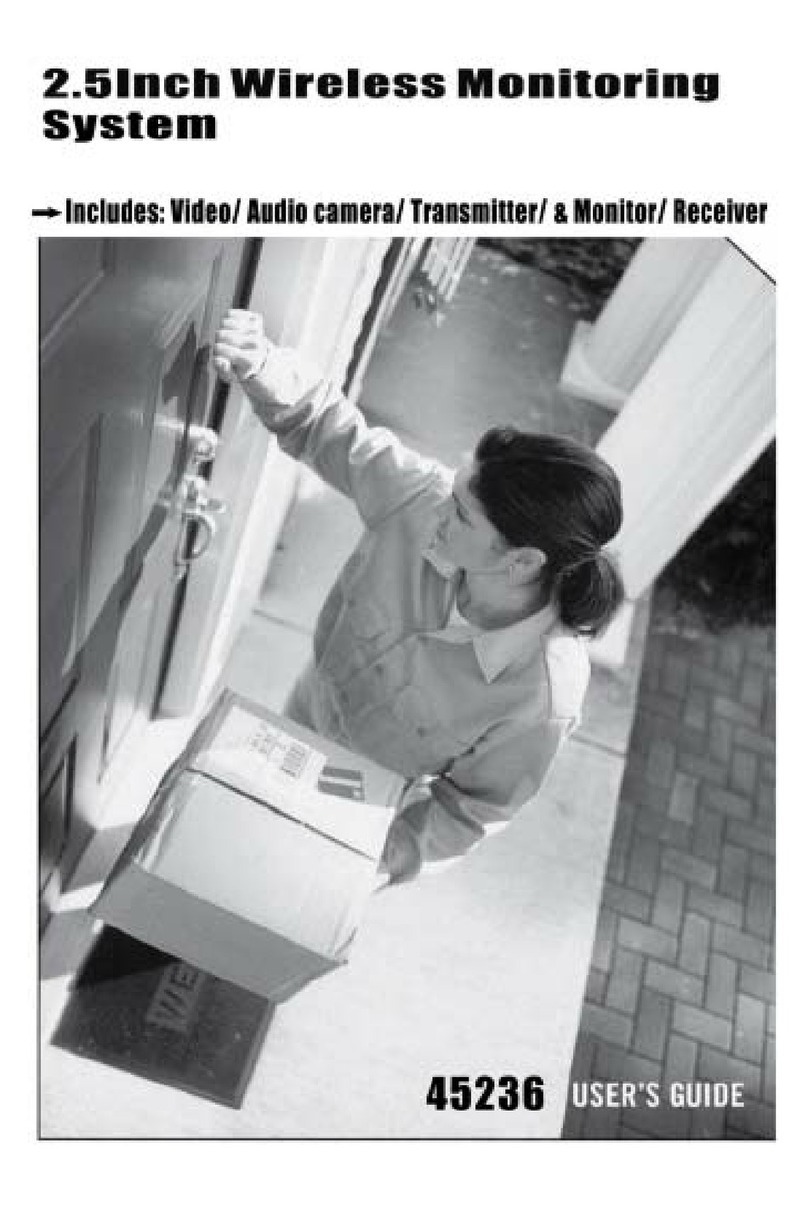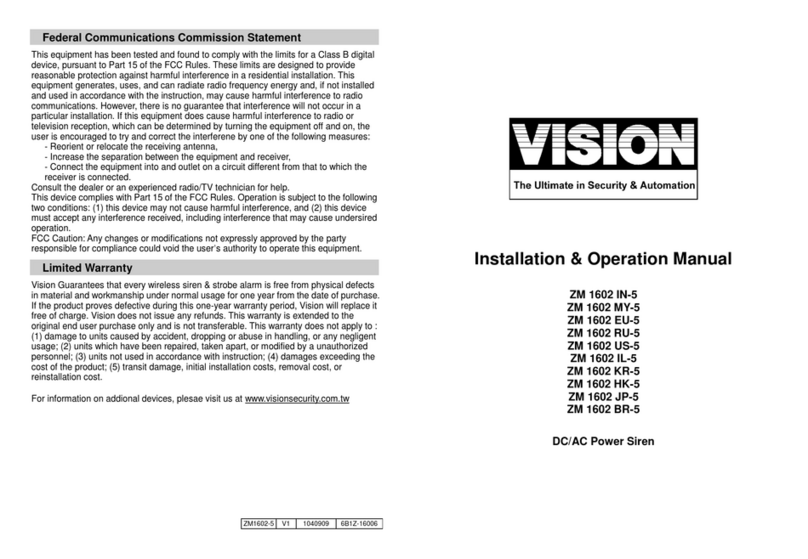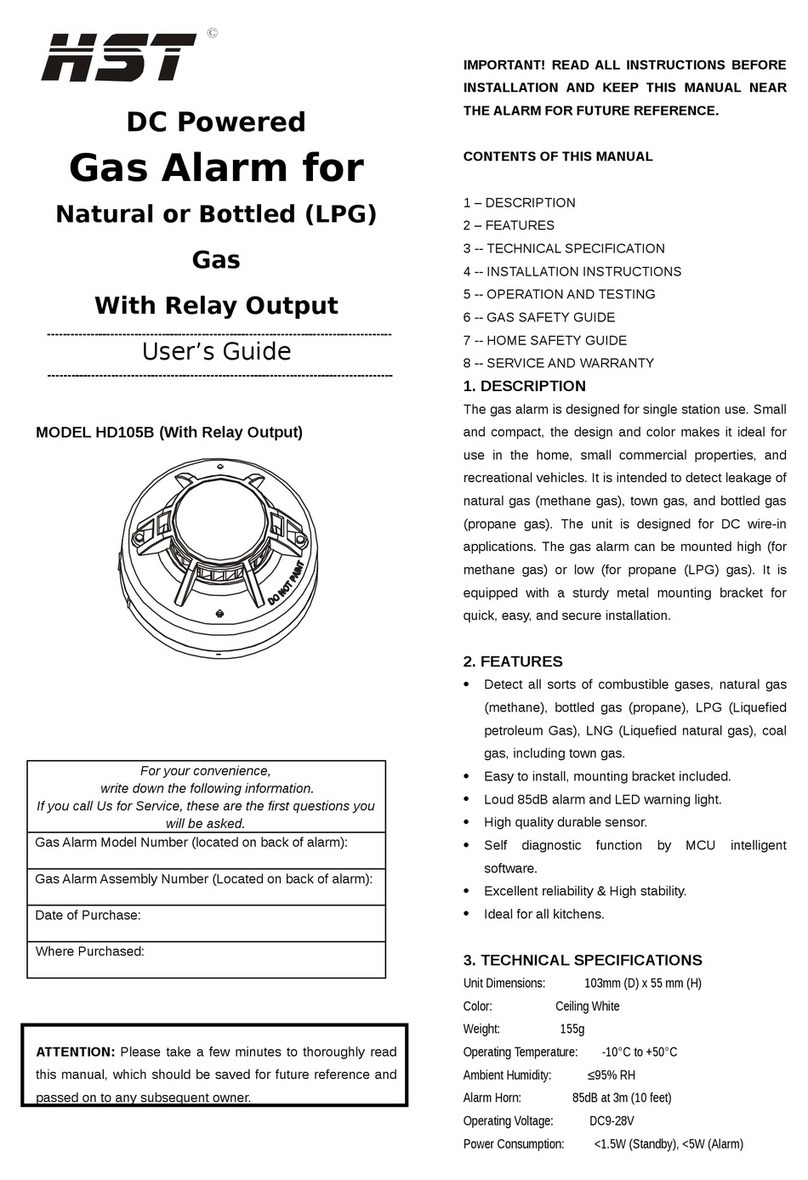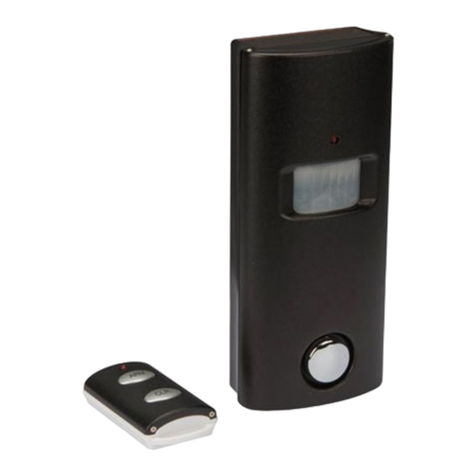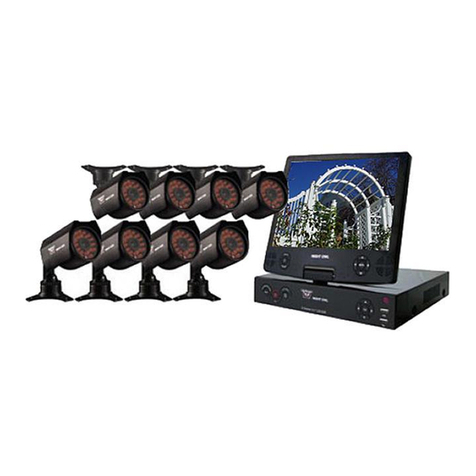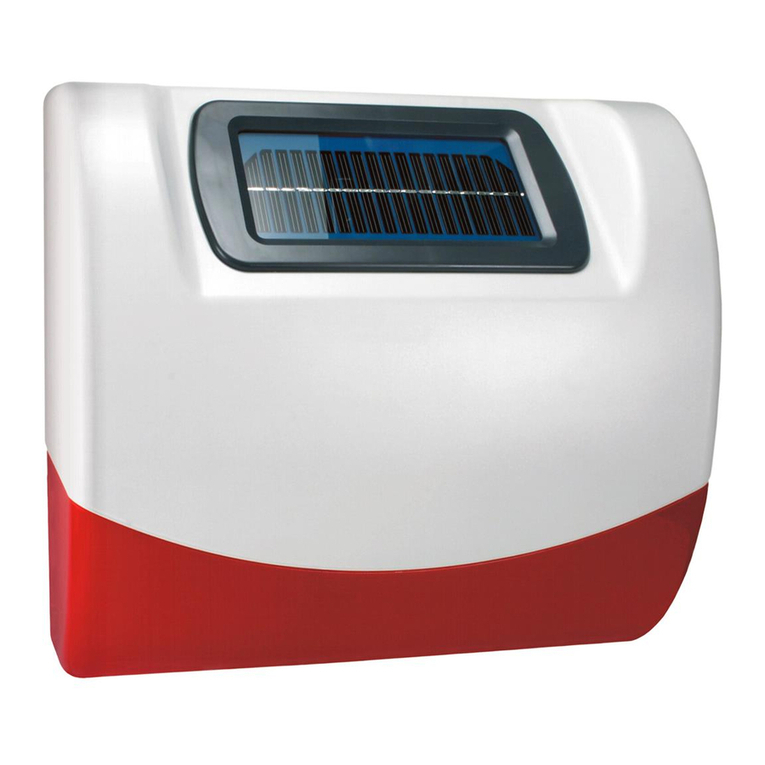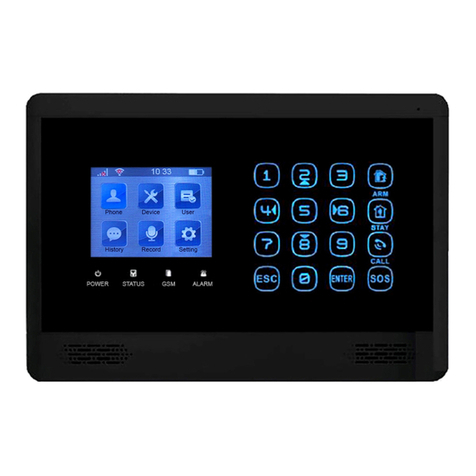Eldes ESIM364 User manual

GSM ALARM AND MANAGEMENT SYSTEM
ESIM364
USER MANUAL

User Manual v1.2
Valid for ESIM364 v02.04.01 and up
Safety instructions
Please read and follow these safety guidelines in order to maintain safety of operators and people around:
• GSM alarm & management system ESIM364 (also referenced as alarm system, system or device) has radio transceiver operat-
ing in GSM 850/900/1800/1900 bands.
• DO NOT use the system where it can be interfere with other devices and cause any potential danger.
• DO NOT use the system with medical devices.
• DO NOT use the system in hazardous environment.
• DO NOT expose the system to high humidity, chemical environment or mechanical impacts.
• DO NOT attempt to personally repair the system.
• System label is on the bottom side of the device.
GSM alarm system ESIM364 is a device mounted in limited access areas. Any system repairs must be done only by quali-
ed, safety aware personnel.
The system must be powered by main 16-24V 50 Hz ~1.5A max or 18-24V 1,5A max DC power supply which must
be approved by LST EN 60950-1 standard and be easily accessible nearby the device. When connecting the power supply
to the system, switching the pole terminals places does not have any aect.
Any additional devices linked to the system ESIM364 (computer, sensors, relays etc.) must be approved by LST EN 60950-1
standard.
Main power supply can be connected to AC mains only inside installation room with
automatic 2-pole circuit breaker capable of disconnecting circuit in the event of short
circuit or over-current condition. Open circuit breaker must have a gap between con-
nections of more than 3mm and the disconnection current 5A.
Mains power and backup battery must be disconnected before any installation or tuning work starts. The system installa-
tion or maintenance must not be done during stormy conditions.
Backup battery must be connected via the connection which in the case of breaking would result in disconnection of one
of battery pole terminals. Special care must be taken when connecting positive and negative battery terminals. Switching
the pole terminals places is NOT allowed.
In order to avoid re or explosion hazards the system must be used only with approved backup battery.
The device is fully turned o by disconnecting 2-pole switch o device of the main power supply and disconnecting
backup battery connector.
Fuse F1 type – Slow Blown 3A. Replacement fuses have to be exactly the same as indicated by the manufacturer.
If you use I security class computer for setting the parameters it must be connected to earth.
Phase
AC 230V
50 Hz/DC 24V
USB cable
Null
PE
ESIM364
AC/DC
The WEEE (Waste Electrical and Electronic Equipment) marking on this product (see left) or its documentation indicates that the
product must not be disposed of together with household waste. To prevent possible harm to human health and/or the environ-
ment, the product must be disposed on in an approved and environmentally safe recycling process. For further information on how
to dispose of this product correctly, contact the system supplier, or the local authority responsible for waste disposal in your area.

Limited Liability
The buyer must agree that the system will reduce
the risk of re, theft, burglary or other dangers but
does not guarantee against
such events.
“ELDES UAB” will not take any responsibility re-
garding personal or property or revenue loss
while using the system. “ELDES UAB” liability ac-
cording to local laws does not exceed value of the
purchased system. “ELDES UAB” is not aliated
with any of the cellular providers therefore is not
responsible for the quality of cellular service.
Manufacturer Warranty
The system carries a 24-month warranty by the
manufacturer “ELDES UAB”. Warranty period starts
from the day the system has been purchased
by the end user. The warranty is valid only if the
system has been used as intended, following all
guidelines listed in the manual and within speci-
ed operating conditions. Receipt must be kept as
a proof of purchase date.
The warranty is voided if the system has been
exposed to mechanical impact, chemicals, high
humidity, uids, corrosive and hazardous environ-
ments or other force majeure factors.
Technical Support
If you require more detailed information on your
system or in case of system failure occurrence,
please, contact your alarm system installer.
About User Manual
This document describes basic conguration and
usage of alarm system ESIM364. It is very impor-
tant to read the user manual before starting to use
the system.
Package Content
1. ESIM364 ................................................ qty. 1
2. Microphone......................................... qty. 1
3. SMA antenna ...................................... qty. 1
4. Backup battery connection wire qty. 1
5. User manual........................................ qty. 1
6. Resistor 5,6kΩ...................................qty. 12
7. Resistor 3,3kΩ..................................... qty. 6
NOTE: For complete system conguration and
control, please refer to ESIM364 installation
manual located at www.eldes.lt/en/download
Copyright © “ELDES UAB”, 2013. All rights reserved
It is not allowed to copy and distribute information in this document or pass to a third party without advanced written authorization
by “ELDES UAB”. “ELDES UAB” reserves the right to update or modify this document and/or related products without a warning. Hereby,
“ELDES UAB” declares that this GSM alarm and management system ESIM364 is in compliance with the essential requirements and other
relevant provisions of Directive 1999/5/EC. The declaration of conformity may be consulted at www.eldes.lt
Contents
1. General Information..................................................................... 4
1.1 Short Description of Main Denitions...............................................4
1.2 EKB2 Keypad Overview...........................................................................5
1.3 EKB3/EKB3W Keypad Overview...........................................................7
1.4 Partitions ......................................................................................................7
2. Technical Specications............................................................... 8
2.1 Electrical & Mechanical Characteristics.............................................8
2.2 Main Unit, LED & Connector Functionality ......................................9
2.3 Wiring Diagrams..................................................................................... 10
2.3.1 General Wiring ......................................................................... 10
2.3.2 Zone Connection Types........................................................10
3. Basic Conguration & Use..........................................................11
3.1 Setting Up Date & Time........................................................................ 11
3.2. Arming, Disarming the System & Turning O the Alarm.........12
3.2.1 Arm, Disarm & Turn o the Alarm by Phone Call......... 12
3.2.2 Arm by SMS text message ...................................................13
3.2.3 Disarm & Turn o the Alarm by SMS text message ....13
3.2.4 Arm by EKB2 Keypad .............................................................14
3.2.5 Disarm & Turn o the Alarm by EKB2 Keypad ..............14
3.2.6 Arm by EKB3/EKB3W Keypad .............................................15
3.2.7 Disarm & Turn o the Alarm by EKB3/EKBW Keypad .15
3.2.8 Arm by iButton® Key .............................................................. 16
3.2.9 Disarm & Turn o the Alarm by iButton® Key ...............16
3.2.10 Arm by EWK1 – Wireless Key-fob.......................................17
3.2.11 Disarm & Turn o the
Alarm by EWK1 – Wireless Key-fob................................... 18
3.3 Activating STAY Mode .......................................................................... 19
3.3.1 Arm by EKB2 Keypad in STAY Mode Manually.............. 19
3.4 Alarm Indications & Viewing Violated Zones / Tampers...........21
3.5 Bypassing & Activating Zones........................................................... 22
3.6 Viewing System Information.............................................................. 23
3.7 Managing Periodical System Information.....................................23
3.8 Viewing Zone & PGM Output Information....................................24
3.9 Managing Temperature Information ..............................................25
3.10 Indication of System Faults.................................................................26
3.11 Controlling Electrical Appliances ..................................................... 28
3.12 Turning ON/OFF the Electrical
Appliances for a Determined Time Period ....................................29
4. If the Alarm System is Connected to Monitoring Station........ 30

4
1. General Information
ESIM364 is an alarm system for private houses, cottages, village houses, garages, warehouses and other buildings, also capable of
turning on/o the electrical appliances by SMS text message and alarm system keypad. This alarm system provides a simple thus
eective way of use.
The system may consist of:
• ESIM364 alarm system device.
• Up to 4 EKB2/EKB3 wired keypads.
• Up to 4 EKB3W wireless keypads.
• Wired and/or wireless detection devices: movement sensors, magnetic door contacts, smoke sensors etc.
• Other devices: indoor/outdoor sirens, zone/PGM output expansion modules, heating, lighting, gates etc.
For more details on ESIM364 system, please, consult with your alarm system installer.
1.1 Short Description of Main Denitions
The following table provides the explanation of main denitions which are met in this user manual.
Denition Description
System; alarm system ESIM364 device
SMS Short Message Service text
Keypad Device with a set keys allowing to congure & control the system, view violated zones & system faults
EKB2 Model of wired LCD keypad
EKB3 Model of wired LED keypad
EKB3W Model of wireless LED keypad
User phone number;
User 1... 10
Phone number of the user allowed to control and receive SMS text messages from the system
System phone number Phone number of the SIM card inserted in ESIM364 device
User password 4-digit combination intended for system arming/disarming using a keypad
iButton® key Small metal tab containing a unique ID code intended for system arming/disarming
Zone Alarm system input for wired and wireless sensor connection
PGM output Alarm system output for connection of electrical appliances (heating, lighting, gates etc.)
Partition Section dividing one alarm system into two or more independent parts software-wise

MANUAL ELDES ESIM364 V1.2
5
1.2 EKB2 Keypad Overview
EKB2 is an LCD keypad intended for using with ESIM364 alarm system.
Keys Functionality
Main Messages & Icons
One menu level back / cancel
Menu navigation – up
Menu navigation – down
Conrm (enter) value
Value typing
Keypad partition switch / minus
symbol for entering negative
temp. value
Additional menu / minus symbol
for entering negative temp. value
...
ready
GARAGE
FLT
BYP
STAY
00:4520,20C
GSM Signal
Strength
System Status
Message
Home Screen
View
Bypass Mode
Indication
Stay Mode
Indication
System
Fault Indi-
cation
Custom
Keypad
Partition
Title
Digital Clock
Temperature
Icon / Message Description
Delay zone violated when system is disarmed.
Exit delay countdown initiated.
System is armed and menu is locked.
System is disarmed and menu is unlocked
+ CONFIGURATION
MODE
Conguration Mode activated.
BURGLARY ALARM Delay, Instant or Follow zone violated when
system is armed.
Icon / Message Description
24 ALARM 24H zone violated.
FIRE ALARM Fire zone violated.
TAMPER ALARM Tamper violated
READY System is ready to be armed.
NOT READY System is not ready to be armed – one or more
zones / tampers violated.
ARMED System is armed (optional feature).
STAY Stay mode activated
BYP One or more zones bypassed
FLT One or more system faults are present
Fig. No. 1

6
EKB2 LCD screen is intended for displaying alarm system status messages and alerts. Message READY is displayed on the screen that
no zones are violated or no faults are present and the system is prepared for arming. Message NOT READY (and F LT ) shows up in case
of zone violation or if system faults are present. The alarm system cannot be armed until the faults are removed or violated zone (-s) is
restored, bypassed or set up to operate under Force mode. The following faults allow system arming when present:
• main power supply is lost.
• low battery.
• battery dead or missing.
• battery failed.
• siren failed.
• GSM jammer detected.
• date/time not set.
• GSM connection failed.
• GSM antenna failed.
Audio Indication
The built-in buzzer uses two types of sound signals – three short beeps and one long beep. Three short beeps stand for successfully
carried out conguration command, one long beep – for invalid conguration command. In addition, the buzzer emits short beeps
in case of alarm.
Visual Indication
EKB2 can be used even in dark premises as the LCD screen and keys are illuminated continuously. The illumination level lowers down
if 3 minutes after the last key-touch expires while the system is disarmed. In case of alarm, the keypad illumination level is boosted
and stays in this state until the system is disarmed.

MANUAL ELDES ESIM364 V1.2
7
1.3 EKB3/EKB3W Keypad Overview
EKB3/EKB3W is a LED keypad intended for using with ESIM364 alarm system.
1 2 3
4 5 6
7
ARMED
READY
SYSTEM BYPS
A B
1
2
3
4
5
6
7
8
9
10
11
12
8 9
*0 #
STAY
BYPS
INST
CODE
LED Functionality
ARMED Alarm system is armed /Conguration mode
READY System is prepared for arming
SYSTEM System faults / valid command is being entered
BYPS Zone bypass mode
1-12 Violated zone
Keys Functionality
[BYPS] Zone bypass mode
[CODE] Additional options - system fault list / violated high zone indication / violated tamper indication
[*] Conguration Mode (when typed as a 1st character) / cancel command (when typed as a 2nd character) / keypad
partition switch (if enabled)
[#] Conrm (enter) command
[0] ... [9] Command typing
[STAY] Manual Stay mode activation
[INST] (currently inactive)
The green indicator READY indicates that no zones are violated or no faults are present and the system is prepared for arming. Yellow
indicator SYSTEM lights up or ashes in case of zone violation or if system faults are present. The alarm system cannot be armed until
the faults are removed or violated zone (-s) is restored, bypassed or set up to operate under Force mode. The following faults allow
system arming when present:
• main power supply is lost.
• low battery.
• battery dead or missing.
• battery failed.
• siren failed.
• GSM jammer detected.
• date/time not set.
• GSM connection failed.
• GSM antenna failed.
Audio Indication
The built-in buzzer uses two types of sound signals – three short beeps and one long beep. Three short beeps stand for successfully
carried out conguration command, one long beep – for invalid conguration command. In addition, the buzzer emits short beeps
in case of alarm.
Visual Indication
EKB3 keys have a LED back-light, therefore it is possible to use this keypad even in dark premises. The back-light lasts for 3 minutes
after the last key-stroke while the system is disarmed. In case of alarm, the keypad back-light turns ON and lasts until the system is
disarmed.
EKB3W keys have a LED back-light, which will be activated once any key is pressed. Due to battery power saving reasons, the back-
light and LED light last for 10 seconds after the last key-stroke.
1.4 Partitions
Your alarm system may be divided into up to 4 partitions: Partition 1 - Partition 4 . Each system partition operates independently
from each other, therefore dividing the system into partitions allows to use 1 alarm system unit to secure up to 4 dierent areas, for
example: oce and warehouse, house and garage etc. By default conguration, the system is NOT divided into partitions and all user
phone numbers, user passwords, keypads, iButton® keys, zones are assigned to Partition 1.
Fig. No. 2

8
2. Technical Specications
2.1 Electrical & Mechanical Characteristics
Electrical & Mechanical Characteristics
Main Power Supply 16-24V 50 Hz ~1.5A max / 18-24V 1,5A max
Current in Standby without External Sensors and Keyboard Up to 80mA
Recommended Backup Battery Voltage, Capacity 12V; 1,3-7Ah
Recommended Backup Battery Type Lead-Acid
Maximum Battery Charge Current 900mA
GSM Modem Frequency 850/900/1800/1900MHz
Cable Type for GSM Antenna Connection Shielded
Number of Zones on Board 6 (ATZ mode: 12)
Nominal Zone Resistance 5,6kΩ (ATZ Mode: 5,6kΩ and 3,3kΩ)
Number of PGM Outputs on Board 4
ESIM364 PGM Output Circuit
Maximum Commuting PGM Output Values Voltage – 30V; Current – 100mA;
BELL: Siren Output when Activated Connected to COM
BELL: Maximum Siren Output Current 1A
BELL: Maximum Cable Length for Siren Connection up to 30 meters
BELL: Cable Type for Siren Connection Unshielded
AUX: Auxiliary Equipment Power Supply Voltage 13,8V DC
AUX: Maximum Accumulative Current of Auxiliary Equipment 1,1A
AUX: Maximum Cable Length for Auxiliary Equipment Connection up to 100 meters
AUX: Cable Type for Auxiliary Equipment Connection Unshielded
BUZ: Maximum Current of Mini Buzzer 150mA
BUZ: Power Supply Voltage of Mini Buzzer 5V DC
BUZ: Cable Type for Mini Buzzer Connection Unshielded
Dimensions 140x100x18mm
Operating Temperature Range -20...+550C
Supported Temperature Sensor Model Maxim®/Dallas® DS18S20, DS18B20
Maximum Supported Number of Temperature Sensors 8
DATA: Maximum Cable Length for 1-Wire® Communication up to 30 meters
DATA: Cable Type for 1-Wire® Communication Unshielded
Supported iButton® Key Model Maxim®/Dallas® DS1990A
Maximum Supported Number of Keyboards 4 x EKB2 / EKB3
Y/G: Maximum Cable Length for RS485 Communication up to 100 meters
Y/G: Cable Type for RS485 Communication Unshielded
MIC: Maximum Cable Length for Microphone Connection Up to 2 meters
MIC: Cable Type for Microphone Connection Unshielded
Wireless Transmitter-Receiver Frequency 868 Mhz
Wireless Communication Range Up to 30m in premises; up to 150m in open areas
Maximum Supported Number of Wireless Devices 32
Event Log Size 500 events
Maximum Supported Number of Zones 76
Maximum Supported Number of PGM Outputs 76
Cable Type for Zone and PGM Output Connection Unshielded
Communications SMS, Voice calls, GPRS network, RS485, CSD, PSTN
Supported Protocols Ademco Contact ID®, 4+2, EGR100, Kronos, Cortex®
1 R OUT Open Collector Output.
Output is pulled to COM
when turned ON.

MANUAL ELDES ESIM364 V1.2
9
2.2 Main Unit, LED & Connector Functionality
Main Unit Functionality
GSM MODEM GSM network 850/900/1800/1900MHz
modem
SIM CARD1 Primary SIM card slot / holder
SIM CARD2 Secondary SIM card slot / holder
DEF Pins for restoring default settings
USB Mini USB port
FUSE F1 3A fuse
W-LESS ANT Wireless antenna SMA type connector
GSM ANT GSM antenna SMA type connector
MODULES* Slots for EA1, EA2 or EPGM8 module
LED Functionality
NETW GSM network signal strength
C1 PGM output C1 status - on/o
C2 PGM output C2 status - on/o
C3 PGM output C3 status - on/o
C4 PGM output C4 status - on/o
STAT Micro-controller status
Connector Functionality
TIP* PSTN (landline) terminal
RING* PSTN (landline) terminal
DATA 1-Wire® interface for iButton key & temperature sensor connection
+5V Temperature sensor power supply terminal (+5V)
MIC- Microphone negative terminal
MIC+ Microphone positive terminal
BUZ- Buzzer negative terminal
BUZ+ Buzzer positive terminal
C1 - C4 PGM output terminals
Z1 - Z6 Security zone terminals
YRS485 interface for communication (yellow wire)
GRS485 interface for communication (yellow wire)
COM Common return terminal
BELL- Siren negative terminal
BELL+ Siren positive terminal
AUX- Negative power supply terminal for auxiliary equipment
AUX+ Positive power supply terminal for auxiliary equipment
AC/DC Main power supply terminals
AKU- Backup battery negative terminal
AKU+ Backup battery positive terminal
* - Optional, implementable on request in advance
Fig. No.1
G S M
MO DE M
ANTW-LESS GSM ANT
TIP
FUSE F1
RING
DEF
SIM CARD1
SIM CARD2
PRG
USB
AK U+
AK U-
C 2
C 3
C 3
C 4
C 4
C 1
S TA T
NE TW
C O M
BELL-
BELL+
G
Y
C2
AUX-
AUX+
AC /DC
AC /DC
Z1
C O M
Z2
Z3
C O M
Z4
DA T A
+5V
M IC -
MIC +
BU Z-
C1
BU Z+
C O M
C O M
Z6
Z5
3A
MODULES
OPENOPEN

10
Type 1 Type 2 Type 3 Type 4 Type 5
Normally open contact
with 5,6KΩ end of line
resistor
Normally closed con-
tact with 5,6KΩ end of
line resistor
Tamper and 5,6KΩ
end of line resistor
and 3,3KΩ end of line
resistor with normally
closed contact
ATZ Mode: 5,6KΩ end
of line resistor and nor-
mally closed contact
with 3,3KΩ end of line
resistor and normally
closed contact
ATZ Mode: Tamper,
5,6KΩ end of line
resistor, 5,6KΩ end of
line resistor with nor-
mally closed contact
and 3,3KΩ end of line
resistor with normally
closed contact.
Fig. No. 3
Fig. No. 2
2.3 Wiring Diagrams
2.3.1 General Wiring
2.3.2 Zone Connection Types
C O M
BELL-
BELL+
G
Y
C2
AUX-
AUX+
AC /DC
AC /DC
Z1
C O M
Z2
Z3
C O M
Z4
DATA
+5V
MIC -
MIC +
BUZ-
C1
BUZ+
C O M
C O M
Z6
Z5
MIC
BUZ
SIREN/BELL
iButton®
key reader
Temperature sensor EKB2EKB3
EPGM1
Z1
Z2
Backup Battery
12V 1.3-7Ah
Metal cabinet
PE terminal
Relay
module
1A max.
Z4
Z3
Z5
Z6
Fuse 500 mA
~230V 50Hz
~16-24V
AKU+
AKU-
5,6 kΩ
5,6 kΩ
5,6 kΩ
5,6 kΩ
5,6 kΩ
5,6 kΩ

MANUAL ELDES ESIM364 V1.2
11
3. Basic Conguration & Use
ATTENTION: System conguration described in this chapter is based on default system parameter values. Your alarm system
installer may have changed those values. For more details, please, contact your alarm system installer.
This chapter provides a description of basic conguration and use of ESIM364 alarm system by the following methods:
• SMS text message.
• Phone call.
• EKB2 keypad.
• EKB3 keypad.
• EKB3W wireless keypad.
• iButton® key.
• EWK1 wireless keyfob.
In order to congure and control the system using SMS text message, send the text command to the ESIM364 system
phone number from one of the preset user phone numbers. In this user manual the underscore symbol ”_” represents one
space character. Every underscore symbol must be re placed by a single space character. There must be no spaces or other
unnecesary characters at the beginning and at the end of the message. ssss – 4-digit SMS password set by your alarm
system installer.
The system conguration and control by EKB2 keypad is performed by navigating throughout the menu section list dis-
played on LCD screen. To navigate in the menu path, touch ↓, ↑ keys to select the desired menu section and touch OK key
to open the selected section. To enter a required value, use 0... 9 keys and touch OK key for value conrmation or cancel/
go one menu section back by touching ←key. The value can be typed in directly by touching 0... 9 keys while highlighting
the desired menu section. EKB2 menu type is “circle”, therefore when the last section in the menu list is selected, you will
be brought back to the beginning of the list after touching the ↓ key. In this user manual, the menu path is provided under
“tree” view by starting at home screen view. In this user manual valid parameter range is indicated in brackets..
The system conguration and control by EKB3/EKB3W keypad is performed by entering a valid conguration command
using the number keys 0... 9 and [#] key for conrmation. Some commands require [BYPS], [CODE] and [STAY] keys as well.
The structure of standard conguration command is a combination of digits. In this user manual, valid parameter range
is indicated in brackets.
3.1 Setting Up Date & Time
NOTE: When the alarm system is connected to a monitoring station the date and time are set automatically. The system retrie-
ves this data from the monitoring station by itself.
SMS
SMS
EKB2
EKB2
EKB3/
EKB3W
1. Send the following SMS text message to the phone number of ESIM364 alarm system:
SMS text message content:
ssss_yyyy.mm.dd_hr:mn
Value: yyyy – year; mm – month, range – [01... 12]; dd – day, range - [01... 31]; hr – hours,
range – [00... 23], mn – minutes, range – [00... 59].
Example: 1111_2011.12.15_13:45
2. The system will reply with conrmation by SMS text message to user phone number who sent the SMS text
message after the date & time is set successfully.
Navigate through the following menu path using OK and arrow keys and
enter the date and time values using the number keys:
Menu path:
OK →DATE/TIME SET → OK → yyyy-mm-dd_hr:mn → OK
Value: yyyy – year; mm – month, range – [01... 12]; dd – day, range - [01... 31]; hr – hours,
range – [00... 23], mn – minutes, range – [00... 59].
Example: 2011-12-15 13:45

12
3.2. Arming, Disarming the System & Turning O the Alarm
Before arming the system it is necessary to close all doors and windows in the secured area and move yourself away from the move-
ment detection eld.
Fig. No. 7
User ESIM364
CALL
SMS
1. To arm, disarm the system & turn o the alarm, make a phone call to the system‘s phone number from any of
10 available user phone numbers. The phone call is free charge as the system rejects it and carries out arming/
disarming procedure after-wards. When arming – the system rejects the phone call after 2 rings, when disarming
– the system rejects the phone call immediately.
2. When the system is successfully armed or disarmed, it will reply with conrmation by SMS text message to the
user phone number that made a phone call.
3. When attempting to arm the system in case of violated zone / tamper presence, the system will reply with viola-
ted zone / tamper number. For more details, please refer to chapter 3.5 Bypassing & Activating Zones.
3.2.1 Arm, Disarm & Turn o the Alarm by Phone Call
ATTENTION: User must leave the secured area before arming the system by phone call.
Close all
windows
Don’t stand in
movement sensor
detection zone
Close all
doors
Close all
doors
Fig. No. 6

MANUAL ELDES ESIM364 V1.2
13
3.2.3 Disarm & Turn o the Alarm by SMS text message
1. The system will initiate the entry delay countdown (by default – 15 seconds) after the user has entered the
secured area. Entry delay countdown is intended for user to enter a valid user password before the alarm is
caused.
2. To disarm the system or turn o the alarm, send the following SMS text message to the system‘s phone number
from any out of 10 preset user phone numbers:
SMS text message content:
ssss_DISARMp or ssss_DISARMp,p,p,p
Value: p - partition number, range - [1... 4]
Example: 1111_ARM1,3,4
3. When the system is successfully disarmed, it will reply with conrmation by SMS text message to the user
phone number that sent the SMS text message.
1. Leave the secured area.
2. To arm the system, send the following SMS text message to the system‘s phone number from any out of 10 preset
user phone numbers:
SMS text message content:
ssss_ARMp or ssss_ARMp,p,p,p
Value: p - partition number, range - [1... 4]
Example: 1111_ARM1
3. When the system is successfully armed, it will reply with conrmation by SMS text message to the user phone
number that sent the SMS text message.
4. When attempting to arm the system in case of violated zone / tamper presence, the system will reply with
violated zone / tamper number. For more details, please refer to chapter 3.5 Bypassing & Activating Zones.
3.2.2 Arm by SMS text message
Fig. No. 8
User ESIM364
SMS
SMS
SMS
Fig. No. 9
User ESIM364
SMS
SMS
SMS

14
1. To arm the system, enter any out of 30 available 4-digit user passwords using the number keys:
Enter user password (and select partition):
If only 1 partition is enabled: uuuu → OK →
If more than 1 partition is enabled: uuuu → OK →[p] part-name → OK
Value: uuuu – 4-digit user password; p – partition number, range – [1... 4], part-name – up to 15 characters
partition name.
Example: 1111 →OK →[2] PART2 → OK
2. The system will initiate the exit delay countdown (by default – 15 seconds) intended for user to leave the secu-
red area. The exit delay is indicated by short beeps emitted by keypad buzzer, buzzer connected to the alarm
system (if any) and icon displayed next to the countdown timer on EKB2 keypad screen.
3. When the system is successfully armed, it will reply with conrmation by SMS text message to User 1 phone
number (by default) and the keypad will display icon on the screen for 5 seconds and switch to home scre-
en view.
4. When attempting to arm the system in case of violated zone / tamper presence, the system will reply with
violated zone / tamper number. For more details, please refer to chapter 3.5 Bypassing & Activating Zones.
1. The system will initiate the entry delay countdown (by default – 15 seconds) after the user has entered the
secured area. Entry delay countdown is intended for user to enter a valid user password before the alarm is
caused. The countdown is indicated by short beeps emitted by keypad buzzer and by long steady beep emit-
ted by buzzer connected to the alarm system (if any).
2. To disarm the system or turn o the alarm, enter any out of 30 available 4-digit user passwords using the num-
ber keys:
Enter user password (and select partition):
If only 1 partition is enabled: uuuu → OK →
If more than 1 partition is enabled: uuuu → OK →[p] part-name → OK
Value: uuuu – 4-digit user password; p – partition number, range – [1... 4], part-name – up to 15 characters
partition name.
Example: 1111 →OK →[2] PART2 → OK
3. When the system is successfully armed, it will reply with conrmation by SMS text message to User 1 phone
number (by default) and if:
• only 1 partition is enabled, the keypad will display icon on the screen for 5 seconds and switch to home
screen view.
• more than 1 partition is enabled, the keypad will display part-name DISARMED message on the screen for
3 seconds and switch to partition selection menu.
EKB2
EKB2
3.2.4 Arm by EKB2 Keypad
3.2.5 Disarm & Turn o the Alarm by EKB2 Keypad
Fig. No. 10
Fig. No. 11
1
7
4
2
8
5
0
3
9
6
1
7
4
2
8
5
0
3
9
6

MANUAL ELDES ESIM364 V1.2
15
3.2.7 Disarm & Turn o the Alarm by EKB3/EKBW Keypad
1. The system will initiate the entry delay countdown (by default – 15 seconds) after the user has entered the
secured area. Entry delay countdown is intended for user to enter a valid user password before the alarm is
caused.
2. To disarm the system or turn o the alarm, enter any out of 30 available 4-digit user passwords using the
number keys:
Enter user password:
uuuu
Value: uuuu – 4-digit user password
Example: 1111
3. When the system is successfully armed, it will reply with conrmation by SMS text message to User 1 phone
number (by default) and EKB3/EKB3W red indicator ARMED will light OFF
1. To arm the system, enter any out of 30 available 4-digit user passwords using the number keys:
Enter user password:
uuuu
Value: uuuu – 4-digit user password
Example: 1111
2. The system will initiate the exit delay countdown (by default – 15 seconds) intended for user to leave the secu-
red area. The countdown is indicated by short beeps provided by keypad built-in buzzer (if any).
3. When the system is successfully armed, it will reply with conrmation by SMS text message to User 1 phone
number (by default) and EKB3/EKB3W red indicator ARMED will light ON.
4. When attempting to arm the system in case of violated zone / tamper presence, the system will reply with violated
zone / tamper number. For more details, please refer to chapter 3.5 Bypassing & Activating Zones.
Fig. No. 12
Fig. No. 14
Fig. No. 13
User ESIM364
SMS
3.2.6 Arm by EKB3/EKB3W Keypad
1
7
4
2
8
5
0
3
9
6
1
7
4
2
8
5
0
3
9
6
Fig. No. 15
User ESIM364
SMS
EKB3/
EKB3W
EKB3/
EKB3W

16
1. The system will initiate the entry delay countdown (by default – 15 seconds) after the user has entered the secured
area. Entry delay countdown is intended for user to enter a valid user password before the alarm is caused.
2. To disarm the system or turn o the alarm, touch the iButton® key reader by any out of 5 iButton® keys:
3. When the system is successfully disarmed, it will reply with conrmation by SMS text message to User 1 phone
number (by default).
1. To arm the system, touch the iButton® key reader by any out of 5 iButton® keys:
2. The system will initiate the exit delay countdown (by default – 15 seconds) intended for user to leave the secu-
red area. The countdown is indicated by short beeps provided by ESIM364 buzzer (if any).
3. When the system is successfully armed, it will reply with conrmation by SMS text message to User 1 phone
number (by default).
4. When attempting to arm the system in case of violated zone / tamper presence, the system will reply with violated
zone / tamper number. For more details, please refer to chapter 3.5 Bypassing & Activating Zones.
Fig. No. 16
Fig. No. 17
User ESIM364
SMS
3.2.8 Arm by iButton® Key
3.2.9 Disarm & Turn o the Alarm by iButton® Key
Fig. No. 18
Fig. No. 19
User ESIM364
SMS

MANUAL ELDES ESIM364 V1.2
17
1. To arm the system, press 1 out of 4 EWK1 buttons (by default – button) assigned to arm the alarm system.
2. The system will initiate the exit delay countdown (by default – 15 seconds) intended for user to leave the secured area.
3. When the system is successfully armed, it will reply with conrmation by SMS text message to User 1 phone number
(by default).
4. When attempting to arm the system in case of violated zone / tamper presence, the system will reply with
violated zone / tamper number. For more details, please refer to chapter 3.5 Bypassing & Activating Zones.
3.2.10 Arm by EWK1 – Wireless Key-fob
Arm the
system
Fig. No. 20
Fig. No. 21
User ESIM364
SMS
EWK1

18
3.2.11 Disarm & Turn o the Alarm by EWK1 – Wireless Key-fob
1. The system will initiate the entry delay countdown (by default – 15 seconds) after the user has entered the secu-
red area. Entry delay countdown is intended for user to enter a valid user password before the alarm is caused.
2. To disarm the system or turn o the alarm, press 1 out of 4 EWK1 buttons (by default – button) assigned to
disarm the alarm system
3. When the system is successfully disarmed, it will reply with conrmation by SMS text message to User 1 phone
number (by default).
Disarm the
system
Fig. No. 22
Fig. No. 23
User ESIM364
SMS
EWK1

MANUAL ELDES ESIM364 V1.2
19
3.3 Activating STAY Mode
NOTE: Delay Zone Becomes Instant in Stay Mode feature may be enabled on your system. In that case the alarm will be
caused instantly instead of entry delay countdown being initiated if a delay zone becomes violated while the system
is operating in Stay mode. For more details, please, contact your alarm system installer.
3.3.1 Arm by EKB2 Keypad in STAY Mode Manually
EWK1
EKB2
EKB2
EKB3
Stay mode allows the user to remain in the secured area after arming the system. In Stay mode, the system does not
cause the alarm when the zones, set up to operate under this mode, become violated. This mode is usually used
when arming the system before night.
There are two ways to activate Stay mode:
• Automatic - This mode is activated automatically in case the user does not leave the secured area (if delay zone
is not violated and restored) during exit delay countdown when arming the system.
• Manual - The system goes into Stay mode after the user opens an additional menu or presses [STAY] key and
enters a valid user password by EKB2 and EKB3/EKB3W keypad respectively.
There is no exit delay countdown when activating Stay mode manually.
Stay mode status is indicated in the home screen view of EKB2.
Stay mode is NOT activated when arming the system by phone call or SMS text message.
1. Navigate through the following menu path using P2 and arrow keys and enter a valid user password using the
number keys to arm the system in Stay mode manually:
Menu path:
If only 1 partition is enabled: P2 →uuuu → OK
If more than 1 partition is enabled: P2 →uuuu → OK →[p] part-name → OK
Value: uuuu - 4-digit user password
2. When the system is successfully armed, it will reply with conrmation by SMS text message to User 1 phone
number (by default).
For more details on how to disarm & turn o the alarm by EKB2 keypad, please refer to chapter 3.2.5 Disarm & Turn o
the Alarm by EKB2 Keypad.
User ESIM364
SMS
Fig. No. 24

20
User ESIM364
SMS
EKB3 1. Arm the system in Stay mode manually by entering the following combination using [STAY] and number keys:
Press the [STAY] key & enter user password:
STAY uuuu
Value: uuuu - 4-digit user password
Example: STAY1111
2. When the system is successfully armed, it will reply with conrmation by SMS text message to User 1 phone
number (by default).
For more details on how to disarm & turn o the alarm by EKB3/EKB3W keypad, please refer to chapter 3.2.7 Disarm &
Turn o the Alarm by EKB3/EKB3W Keypad.
3.3.2 Arm by EKB3/EKB3W Keypad in STAY Mode Manually
Fig. No. 25
Other manuals for ESIM364
5
Table of contents
Other Eldes Security System manuals


